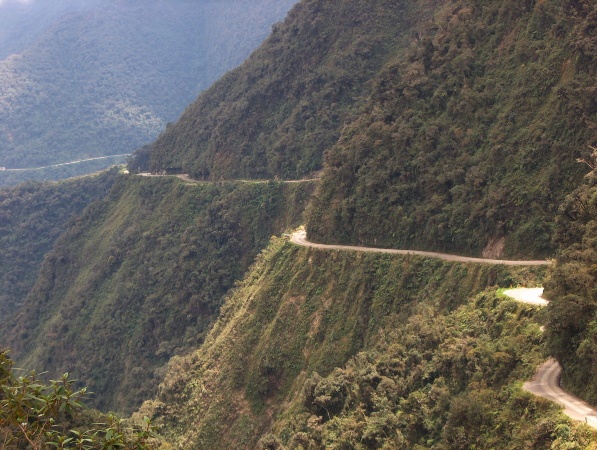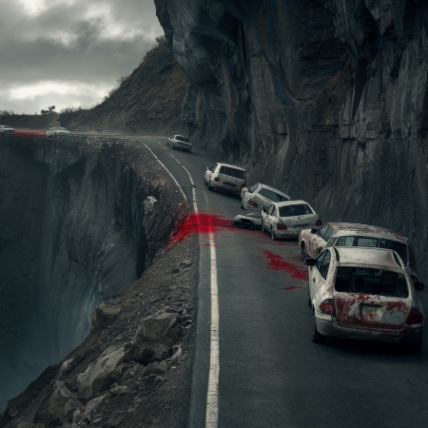Fear Reaches New Heights in Bolivia Road of Death
In some places across the globe, you can understand the danger they offer to the ones visiting them by their common nickname. We described such places on this website, for example, the island of snakes in Brazil or “The Gates of Hell” in Turkmenistan. The road of death in Bolivia, unfortunately, got its name rightly. On the one hand, it is a breathtaking location that can provide an experience full of adrenaline. On the other hand, it is undoubtedly one of the most dangerous places you can find in South America, or even in the entire world.

What Is Bolivie Road Of Death?
“Road of Death” (“Camino de la Muerte”) is the common name of the North Yungas Road (“Camino a los Yungas”), located in Bolivia. This road connects the capital city of La Paz with Coroico, or in fact between La Paz and the Amazon forests of Bolivia. If you ask how long is the yungas road, the simple truth is about 70 kilometers.
The history of the North Yungas Road begins in the 1930s when it was paved by Paraguayan prisoners during the Chaco War between Bolivia and Paraguay in 1932-1935. Many of these prisoners were killed during the works. Unfortunately, Death Road’s death toll doesn’t stop here.
So What’s so scary here? Well, the fact is the Yungas Road location is as creepy as hell. Road of Death offers a journey over a precipice of about 350 meters, on a particularly rickety dirt road carved on the sides of a towering mountain chain. The width of the road is only three and a half meters at maximum – without a guardrail, of course – and the road is characterized by ups and downs that would not put a roller coaster in an amusement park to shame.
La Paz, as we know, is one of the highest cities in the world, with a height of about 3,500 meters. At the beginning of the route, if that’s not enough, you climb the Andes, at a height of about 4,650 meters above sea level. From this point, the decline is gradual but dramatic by any measure. In some sections, you go down to a height of about 1,200 meters “only” so that there are differences of about three kilometers between the heights in different parts of the route. During this transition, the scenery changes, the plateau turns into a rainforest and you discover sights of cliffs, slopes, valleys, huge waterfalls passing over the heads of the travelers or under them, and a multitude of gems. The problem is that this paradise can turn into hell on earth in a matter of seconds.

In North Yungas Road, You Can’t Make A Wrong Turn
The driving conditions make the task very difficult: from fog to rain and mud, which makes driving difficult even for the most skilled drivers. At such significant heights above the ground, the chances that you will encounter clouds or fog that impair visibility are definitely high. As in any self-respecting horror or disaster movie, another danger is the collapse of large rocks or pieces of land due to weather conditions or the ravages of time. For this reason, it’s safer to visit North Yungas Road, Bolivia during the dry season in the country.
If you thought your daily driving to work during rush hour was a challenge, think again. In a large part of the North Yungas Road, the route is narrow and only enough for one vehicle: especially if one of the vehicles is a jeep or a bus, as indeed happens quite a bit. The right of way in this context will be for the driver coming from below, so the driver going downhill must stop and stick to the outside edge of the road as much as possible.
By the way, the level of danger decreases significantly when you do the route from Rohrenbeke to La Paz, and not in the opposite direction, for the simple reason that driving this way is uphill, and just as important: next to a cliff and not an abyss.
Some argue that the road is not as dangerous as its name implies and that there are equally dangerous areas to stay in in Bolivia itself. Not far from there is the South Yungas road, which connects the capital of Bolivia and Cholomani, which is considered no less threatening. Some would say that in some parts of Bolivia, the simple task of crossing a road becomes a real challenge.

And yet, there is no doubt that this route received its name, and also the dubious title of “the most dangerous road in the world” in 1995, with full justice. It is estimated that in the 1990s, about 200-300 people lost their lives on the Bolivia Yungas Road every year. Some accidents are the worst in Bolivian history: for example, the Yungas Road bus accident 1983 ended the lives of over 100 passengers. The crosses and tombstones scattered along the route are a silent testimony to some of these deaths.
Want to Stay Alive? Follow The Rules of North Yungas Road!
In addition to this, the local traffic laws are different from those that characterize Bolivia as a whole: for example, while in Bolivia itself you drive on the right, on North Yungas Road driving is on the left so that the driver can better see how far his outer wheel stands just above the abyss.
To make it even more complex, the Bolivian authorities prohibit driving on Death Road after dark and close the road every evening. Since the route of a vehicle passing through the road of death can last from about 18 hours to more than one day, it is clear that a problem may arise here even if you leave in the early morning hours. Those who can’t complete the route during the day, as happens quite often, have to spend the night on the side of the road. Some will see it as an experience, others as a horror movie scene.
Under these conditions, the Bolivian road of death has become a highly sought-after destination for cyclists who enjoy a downhill ride here for no less than 64 kilometers. The truth is that on a bicycle, maneuvering is inherently much simpler compared to a bus. Even in these conditions, there is no doubt that the Yungas Road mountain bike experience is mainly suitable for experienced riders. Many will also recommend not compromising on the bike, and choosing a model that can handle the stones, mud, and other obstacles of the route.

Should You Visit The Road Of Death In Bolivia?
We may ask why people visit old Yungas Road nowadays, considering the hazards it offers. If in the past it was a common way of moving between La Paz and Coroico or the Amazon forests in the north of the country, today there are enough alternatives. You can take a domestic flight between La Paz and Rohrenbeke. The problem is that finding a ticket for these flights it’s rather difficult unless you book a long time in advance. Moreover, flights change or are canceled in Bolivia frequently.
Another option for moving between these two destinations is using a road that was opened in 2006. This road offers much safer driving between the two cities: yes, with bridges, guardrails, canals for draining rainwater, asphalt, and even some lanes. This new road significantly reduced the journeys on the Road of Death, and accordingly the number of deaths. Today, fewer people pass through the Road of Death Bolivia, thank God.
You will still find quite a few vehicles or cyclists, who visit independently or as part of an organized trip. If you choose to visit North Yungas Road Bolivia in an organized manner with a company, it is very important to see its reputation and not compromise. The price can range from tens to hundreds of dollars per person.
Like many other scary destinations, including those that showcase nature in all its beauty, North Yungas Road will likely continue to attract tourists from all over the world in the coming years. Some tourists are attracted to the breathtaking natural sights, while others are to the adrenaline that arises in each section of the route. Either way, one can only hope that the nickname “Death Road” will remain only on paper.
Here are some of the tours on The Death Road
💀 Killer Deals & Scary Recommendations 💀
🎭 Costumes & Accessories
HalloweenCostumes Fun Costumes Entertainment Earth
🛒 Online Shopping
AliExpress Amazon Walmart Etsy
🧛 Collectibles & Horror Brands
Funko Hot Topic Lego Spirit Halloween
🎢 Attractions & Tours
GetYourGuide Tiqets Viator Klook
📖 Blogs & Horror Sites
Bloody Disgusting iHorror Fangoria
🩸 Disclaimer: Some links are affiliate links. The price stays the same – it just helps keep the site alive 👻





